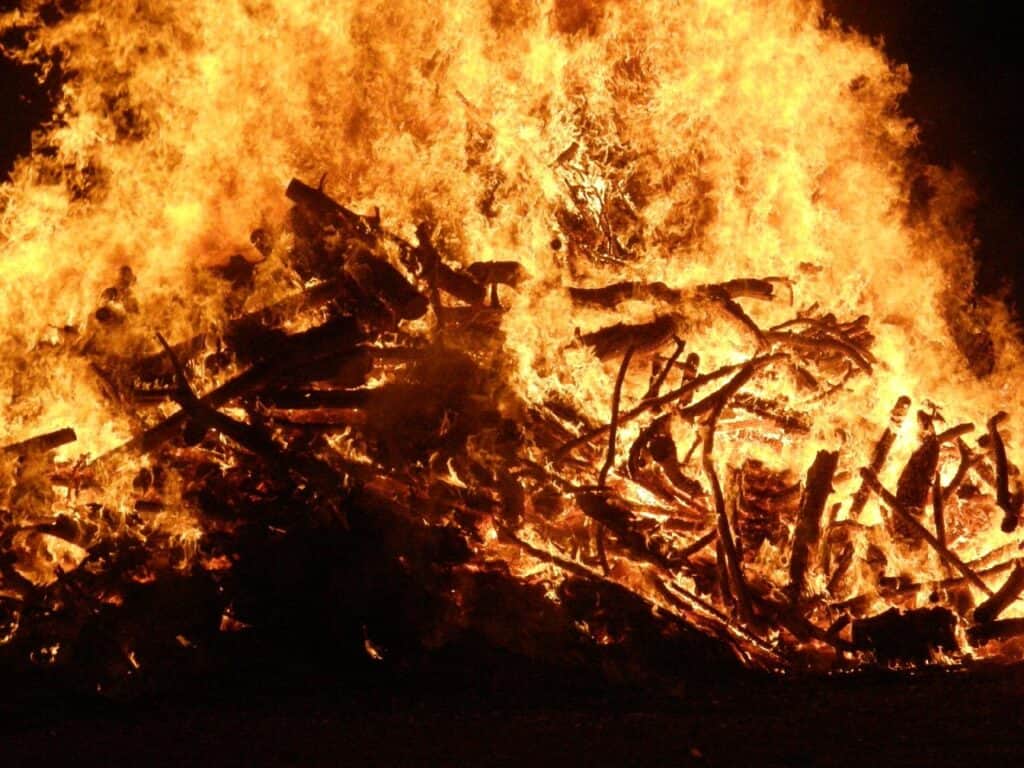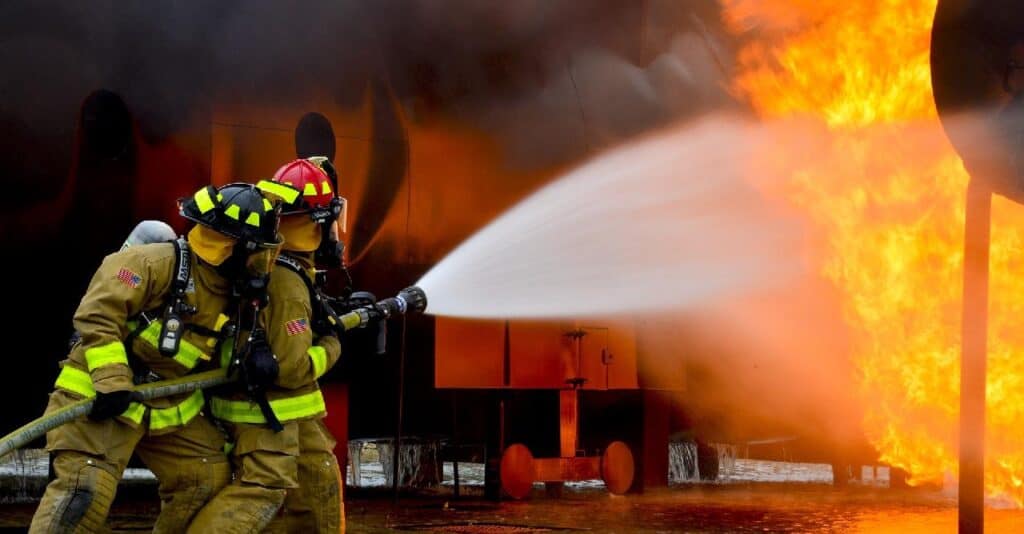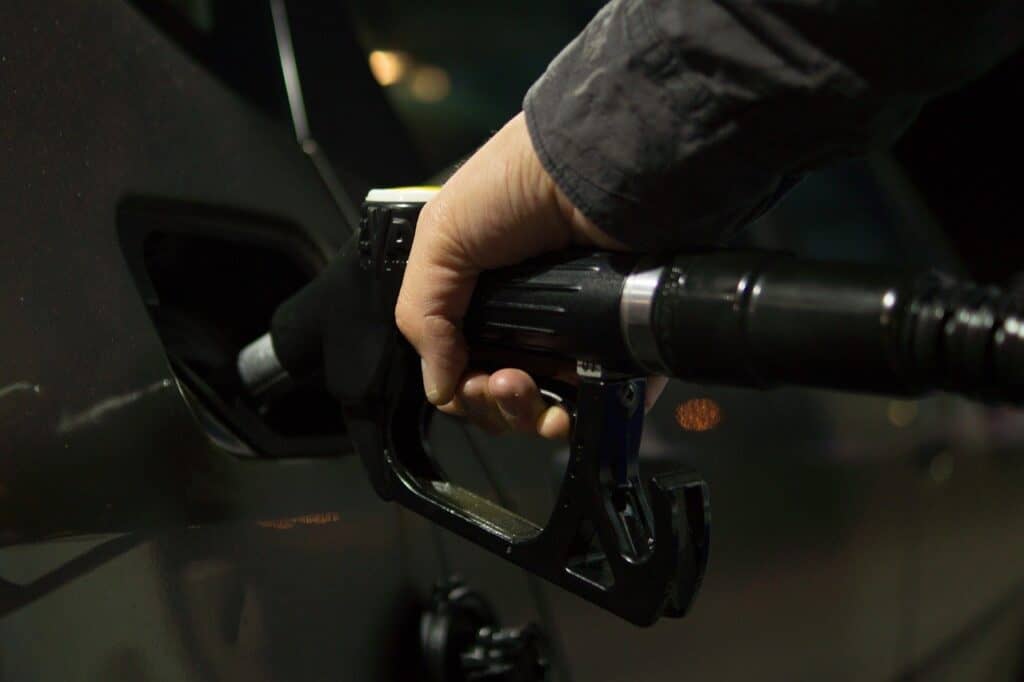Fire. It was once thought of as one of the four elements that made up the universe. It enabled mankind to raise itself out of the wilderness and into cities. It is responsible for light and heat and warmth in the coldest places, and it can be unbelievably dangerous as well. It is so commonplace that we almost take it for granted, but many of us never ask even basic questions about fire, such as just how hot is fire, anyway?
The temperature of fire can range from around 400 degrees Fahrenheit up to 9000 degrees Fahrenheit (200 to 4980 degrees Celsius). The temperature will vary based on things like fuel source and oxygen content. There are even examples of “cold fire” that will not burn you.
Fire is a fascinating phenomenon. Let’s take a look at more of the science of fire and how it affects the wide range of temperatures you may encounter. So, here’s what you need to know about fire.
Your # 1 priority is keeping your family safe. As a firefighter, I recommend everyone has updated smoke detectors that don’t require battery changes, like these ones from Kidde, a fire extinguisher, like this one from Amerex, and a fire escape ladder if you have bedrooms above the first floor, I recommend this one from Hausse.
Also read: House Fire Temperature: How Hot Does It Get?
What Is Fire?

Fire is the result of an exothermic (that means it gives out heat) chemical reaction in which one material is quickly oxidized (loses electrons) to release heat, light, chemical byproducts and occasionally sound too.
Just because it looks like fire, that doesn’t mean it is.
For example, there is no oxygen on the sun (or, indeed, on any star) and while the process may look like “fire”, it’s not. It’s the nuclear fusion of hydrogen into helium and as such, it’s not “fire” by the standard definition.
You must have oxygen to have a fire. Well, you must have an “oxidizing agent” present, which isn’t always oxygen or even an oxygen compound but – there are also no alternative oxidizing agents on the sun, either.
Fire starts when any flammable or combustible material is given enough heat and supply of oxygen (or oxidizing agent) and potentially a spark or naked flame to allow it to burn. Fire is a chain reaction, so the process requires that the burning reaction be hot enough that it can self-sustain.
Thus, fire is the combination of heat, fuel (the stuff to be burned), oxygen (or an oxidizing agent), and a chain reaction that continues to allow that combination without any additional effort.
- They call this the “fire tetrahedron” (a more complete version of the fire triangle).
For a more complete explanation of the fire tetrahedron, watch this:
If any of these four elements are missing, then you don’t have a fire on your hands.
Though in some rare cases, you may also need a fifth element for fire “a catalyst”. That is a substance that is not consumed or used up in the reaction, but which is essential for it to take place in the first place.
There is, in fact, one more element that is essential for many fires to take place, but it tends to go unnoticed because it is always present here on Earth.
That is gravity.
If you were to start a fire somewhere that there was no gravity – the oxygen supply around the fire would quickly be exhausted and it would not be replaced, because oxygen doesn’t move under its own steam – it moves under gravity using a process known as “thermal convection”.
So, the fire would quickly extinguish itself because it would run out of oxygen and become covered in its own byproducts and non-flammable gases from the surrounding air.
This is one of the reasons that while getting a spacecraft into the atmosphere is a risky proposition, once in space – the risks of fires are very small, indeed.
This video explains some more of the science behind fire:
Also read: Is Fire Flammable? Can It Make More Fire?
Why Is Fire Hot?
Fire is hot because there’s a lot of energy trapped inside the oxygen molecule (or in the cases where oxygen is not present – it’s trapped in the oxidizing agent) and it is released during the fire reaction.
The double bond that binds the two oxygen molecules is broken when it is on fire and the oxygen forms bonds to other compounds, instead. These bonds are stronger than the ones that they replace and thus causes a release of energy.
Strangely, while the bond energies of the fuel in a reaction are not completely irrelevant, they play a much smaller part in creating the heat of fire than the oxygen or oxidizing agent does.
When the energy is released, it is released as heat and light and that is fire.
It’s important to realize that a fire is more than a flame. A flame is just the part of the fire that you can see, there may be other invisible elements to the fire (at least to our human eyes).
That’s why you can get burned by standing too close to fire even if you don’t touch the fire.
Also read: Does Fire Have Mass? What Does It Weigh?
How Hot Does It Get?
OK, so now we know what fire is and why it’s hot – how hot is a fire? This is a much more difficult question to answer, sadly.
What is the temperature of fire?
This isn’t something that you can provide a quick list for.
Different fuels burn at different temperatures. For example, we can say that a wood fire can reach temperatures of up to 2000 degrees Fahrenheit (1093 Celsius), but that’s not a hard rule.
Many woods won’t reach that temperature when burning because their chemical makeup prevents it. A few can get even hotter.
If you need an example of this – think about burning green wood versus burning dry kindling. Green wood burns at a much lower temperature than dry wood does.
Also read: Does Fire Kill Germs/Bacteria/Viruses?
And the temperature of the flame also varies quite substantially depending on how much oxygen is available to you.
Think about propane, a popular fuel that is used in everything from household BBQs to major industries. It has a very hot flame when burning in the air of nearly 3,600 degrees Fahrenheit (1982 Celsius)! That’s quite a bit hotter than our average wood fire, right?
Yet, that’s also nothing compared to how hot propane can burn if you give it more oxygen.
If you burn the propane in pure oxygen the temperature soars to nearly 5,100 degrees Fahrenheit!
That’s a huge difference and all you had to do was change the amount of oxygen available – you’re still undergoing the exact same chemical reaction as when burning propane in air.
There are other fuels that can burn much hotter still, particularly in pure oxygen.
Also read: Is Fire Alive? Properties and Stages of Fire and Flames
Where Is The Hottest Part?
The hottest part of a fire is going to be the base.
Yes, we know, heat rises and it does, but the reaction takes place in the greatest quantities at the base of a fire, and then it diffuses as it rises.
That’s why you can, assuming you do it relatively quickly, move your finger through the top of a candle flame without burning yourself. But if you were to do it at the base of the wick (assuming you somehow avoided the molten wax which would also burn you), you would get a fairly severe burn even if you moved rapidly.
Note: We do not recommend anyone put their hands in or near any fire.
Also read: How Fast Does Fire Spread? (House Fire, Wildfire)
The Color Of A Flame And Its Heat
You can, however, assume that you are on the planet Earth and that conditions around you are fairly normal, gauge the approximate heat of a flame by its color.
You will find, as we’ve already seen, that the hottest color of any given flame is as the base and the coolest at the top.
So, red is usually seen on the outer edge of most flames and blue at the base.
- Red flames tend to be around 977 degrees Fahrenheit to about 1832 degrees (525 to 1000 Celsius)
- Orange flames are hotter, roughly 2012 to 2192 degrees (1100 to 1200 Celsius)
- White flames are even hotter, about 2372 degrees to 2732 degrees (1300 to 1500 Celsius)
- Blue flames are the hottest of them all and can burn as hot as 5432 degrees (3000 Celsius)
Also read: What Is The Hottest Color Of Fire? How Hot is Blue Flame?
If you’re wondering how hot is the lighter that you use for lighting a cigarette?
Well, that can reach up to 3,590.6 degrees! That’s why you often see some blue in the flame of a butane lighter. It’s also why it’s so easy to burn yourself with a cigarette lighter.
In fact, we strongly recommend that you never put your fingers, hands, or any other part of your body in a flame. There are better ways to impress your friends or your date that don’t involve the risk of burns and scarring.
If you want some real-world examples of this, then a candle will burn with a white/orange flame at the hottest point. A wood fire, on the other hand, in your grate at home will burn red. A bonfire may drift between red and white depending on the exact nature of the wood and the wind (and thus oxygen availability).
A Bunsen burner flame at fully open is going to be white or even blue. A propane torch, on the other hand, will offer a blue flame at the hottest part.
We would point out that even a red flame is more than hot enough to inflict severe burns on a person. Knowing that a fire is hotter than this is more useful for curiosity’s sake than as an additional safety measure.
Check out this video for a demo of different colors of fire:
Also read: How Hot Is Lightning? Hotter Than The Sun?
What’s The Coldest Fire Color?
In theory, the coldest possible fire color is black. That is the fuel is burning, but so little energy is being produced that there’s no light being emitted and very little heat too.
In practical terms, we have no idea how you would create such a flame. Most exothermic reactions tend to be quite violently exothermic (it’s one of the many reasons that you can often get an explosion when a fire ignites) and we can’t think of any useful way to create a black flame.
However, it is, without a doubt, theoretically possible and thus, the coolest type of flame.
How Are Fires Extinguished?

Fires are extinguished by removing or separating one of the essential components from that fire (fuel, heat, oxidizer, chemical chain reaction).
You can remove the fuel, the oxygen, the flame, the gravity (well, you probably can’t but this is a debate for a physics forum not a fire safety page), the chain reaction or, if you have one, the catalyst.
We’ve written a lot about what kind of extinguisher you need for which fire, and we won’t repeat that here, but you should be aware that there is a huge variety of ways to extinguish a fire and what works with one fire won’t necessarily work with another.
You should only every use the right kind of material to tackle a fire (if you don’t know what that material is – don’t tackle it) and only ever try to extinguish a fire if you are confident that you will succeed.
Otherwise, call the fire department and move away to a safe place. It’s always better to be safe than sorry when it comes to fire.
And no, the fire department won’t be mad that you called – it’s their job to tackle fires and they’re good at it.
Also read: What Do Firefighters Use to Put Out a Fire?
Can It Get Hotter Than Lava?
Fire can be hotter than lava, but it is not always.
Lava, which is molten rock, is expelled from an active volcano can get very hot. In fact, it can reach a maximum temperature of around 2200 degrees Fahrenheit and that’s pretty hot, indeed.
Lava is thus hotter than the wood fire in your living room or the bonfire in your garden. But fires can get much hotter than 2200 degrees and some can reach up to 5000 degrees! That’s nearly twice as hot as lava is.
So, yes fire can be hotter than lava, though in most cases, it probably won’t be.
Here is some more info about this:
Also read: How Hot Is A Lighter Flame?
Is It Ever Too Cold For Fire?
In theory, it can be too cold for fire. At a temperature of absolute zero, which is -459.67 degrees Fahrenheit, there is no energy present at all.
At this temperature, molecules don’t even vibrate within their own space. So, if you could make something this cold, you could prevent fires, at the cost of preventing just about anything else – certainly, nothing can live at absolute zero, either.
In practical terms, however, it is impossible to create this temperature and though we can get very close to absolute zero, we can’t achieve it.
And at any temperature above absolute zero – a fire is possible. It might be challenging to ignite but it is most definitely possible.
So, in the real world – it is never too cold for a fire.
Can It Ever Be Cold?
Yes. Though it depends on how you define “cold”.
You don’t find cold fire on earth very much, because the earth isn’t that cold. But as we’ve already seen, you can start a fire at any temperature above absolute zero and if the flame is only say, 50 degrees hotter than the temperature at which you started the fire – it will burn cold.
The easiest way to make a cold fire is to head into outer space, where you can create very cold conditions very easily. Of course, the hard part of that is getting into outer space in the first place.
It is possible to make cold fire without going into space, check it out:
Also read: Can Christmas Lights Start A Fire?
Final Thoughts
Fire, as you’ve seen, can burn at a wide range of temperatures from “cold” to about 9000 degrees Fahrenheit. It can’t burn at millions of degrees, however, as that is a process that doesn’t involve any oxidation, so it isn’t technically fire.
You can get a rough idea of how hot a fire is by looking at the color of the flame, but as we’ve already noted – nearly all fires can cause burns, so, please don’t touch the flames.
Related Articles
Burning vs. Melting: What’s The Difference?
How Hot Does Wood Burn? Examined
How Hot Does Propane Burn? Answered

